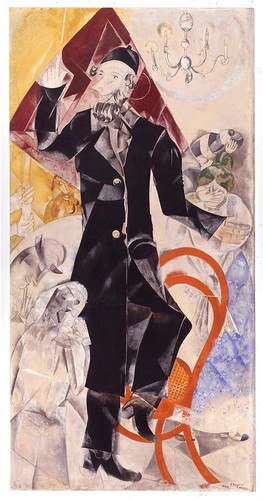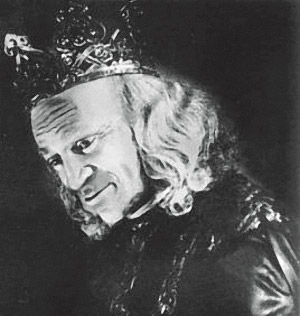History, theater illuminated in CJM's Chagall exhibit
 Marc Chagall, Introduction to the Jewish Theater (detail), 1920, tempera, gouache, and opaque white on canvas. State Tretyakov Gallery, Moscow. © 2008 Artists Rights Society (ARS), New York / ADAGP, Paris.
Marc Chagall, Introduction to the Jewish Theater (detail), 1920, tempera, gouache, and opaque white on canvas. State Tretyakov Gallery, Moscow. © 2008 Artists Rights Society (ARS), New York / ADAGP, Paris.
How do you put theater in a museum? The real answer is: you don't.
A successful museum exhibition about theater, full of artifacts, photos, video, audio – all the remnants of the actual theater experience – invigorates a sense of imagination able to conjure what that experience might have been like. And a really successful exhibit, like Chagall and the Artists of the Russian Jewish Theater, 1919-1949, now at San Francisco's Contemporary Jewish Museum, makes you long for the time-traveling ability to have been there yourself when the curtain went up.
Part of what makes the exhibit, organized last year for The Jewish Museum in New York, so extraordinary is its ability to put theater into a powerful historical context.
With more than 200 artworks and artifacts – from costume sketches to costumes to set designs to posters, photographs and rare video – the exhibit picks up in the heyday of Russian Jewish theater beginning after the 1917 Bolshevik Revolution and tracks primarily two theater companies: Habima, which performed in Hebrew, and the Moscow State Yiddish Theatre (GOSET), which performed in Yiddish.
Habima is represented by two productions. The Dybbuk from 1922 and The Golem from 1925 both look like fascinating productions and introduce us to the work of designer Natan Altman, whose work permeates the entire exhibition. His set for The Dybbuk is represented both as a model and as a sketch, and one of his actual costumes (a white dress worn by Hanna Ravina as Leah) stands like a ghostly presence in the center of the second-floor display area.
Habima's plays were deemed too overtly religious – always a bad thing according to Soviet rule – and the group left Russia by the mid-20s, settled in Palestine and eventually became the state theater of Israel.
GOSET, founded by Aleksei Granovsky in Petrograd in 1918, relocated to Moscow in 1920 and joined forces with a young artist named Marc Chagall, who worked on the production An Evening of Sholem Aleichem. Chagall embraced the theater wholeheartedly, designing sets, costumes and even painting the faces of the actors themselves, all with his customary bright colors and geometrical patterns shaping the theatrical space.
Speaking of the great GOSET actor Solomon Mikhoels (subject of a stunning portrait by Altman), Chagall reportedly said: "Oh, Solomon, if only you had no right eye, I could make you up perfectly!" Mikhoels is a magnetic personality, even in silent film clips. He became part of GOSET even though he was 29, a year older than Granovsky's announced maximum age, because, as Granovsky put it, "he was so ugly he was beautiful."
As impressive as the exhibit is (curated by Susan Tumarkin Goodman, senior curator at The Jewish Museum), you leave with two men foremost in your mind: Chagall and Mikhoels.
For a small GOSET performance space that seated about 90 people, Chagall decided to spread the design from the stage throughout the room. In 1920 he created a series of murals that became known as "Chagall's Box." The tempera-gouache murals disappeared around 1937 but resurfaced many years later. In 1973, Chagall, who had left Russia in the 1920s, returned to Russia and reportedly wept when he saw the murals again and signed them.
The room in which the murals hang is the heart of the exhibition. There's a whimsical "Introduction to the Theater," which, among other things, depicts Chagall himself and no less than three representations of Mikhoels. Under a frieze depicting a traditional Jewish wedding feast are tributes to theater (seen above right, same credits as photo above), dance, music and literature.
Mikhoels (right) pops up again later in the exhibit in a 1935 GOSET production of Shakespeare's King Lear. Lording over this section of the exhibit is a black silk cape with yellow lining worn by Mikhoels as the demented king. Though it was forbidden to criticize the Soviet government—this was after Stalin's devastating Cultural Revolution, after all -- Mikhoels still managed to turn his performance into a critical portrait of Stalin. Aleksandr Tyshler's set design – a sort of Medieval castle in miniature – is fascinating, but the film footage, complete with audio this time, of Mikhoels' performance makes this the production I most wish I had seen of the exhibit's dozen or so plays.
The story of Solomon Mikhoels does not have a happy ending. After working diligently with the Jewish Anti-Fascist Committee and becoming the de-facto leader of Soviet Jews, he was murdered by government thugs in 1948, but the official story is that he was killed in a car accident. In a chilling display, the great actor's shattered glasses, recovered from his body, sit near an enlarged photograph taken the day before his murder.
The strong arm of Soviet rule is apparent in other ways throughout the exhibit. For instance, a sketch of Isaac Rabinovich's designs for the controversial 1921 play God of Vengeance (which involved prostitution and a lesbian love story), are singed at the edges, the near-victims of a 1953 fire thought to be set by the government in an effort to obliterate the archives of Russian Jewish theaters.
Wandering through the exhibit, it's thrilling to see how many of the costume, set and poster designs remain vital and contemporary. Altman's 1922 modernistic set for Uriel Acosta, dominated by a giant wooden sculpture, could make just about any new play more interesting. The same is true for Rabinovich's ladders, platforms and red awnings created for 1922's The Sorceress. The set design just cries out for actors to crawl all over it, which they apparently did with abandon in this circus-like production.
Anyone who cares about theater and needs to be reminded just how important – artistically and historically – theater can be needs to experience this exhibit. And be sure to avail yourself of the excellent audio tour narrated by actor Liev Schreiber and featuring scenes from some of the plays performed by The National Yiddish Theater Folksbiene.
FOR MORE INFORMATION:Chagall and the Artists of the Russian Jewish Theater, 1919-1949 continues through Sept. 7 at The Contemporary Jewish Museum, 736 Mission St. (between 3rd & 4th streets), San Francisco. The museum is open daily (except Wednesday) 11 a.m.-5 p.m. and Thursdays 1 p.m.-8 p.m. Admission is $10 for adults, $8 for students and senior citizens with a valid ID, and $5 on Thursdays after 5 p.m. Admission for youth 18 and younger is always free. Visit www.thecjm.org or call 415-655-7800.

